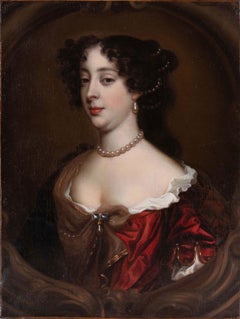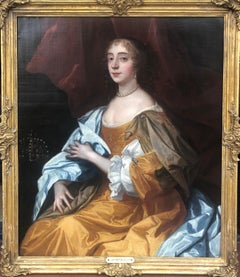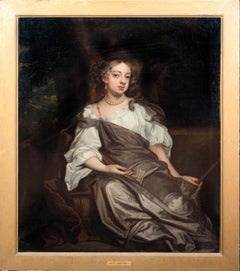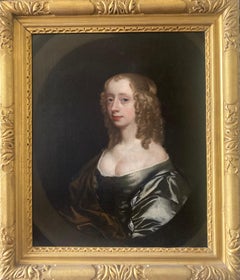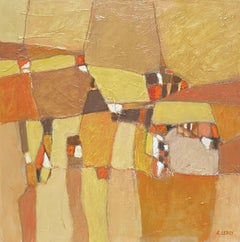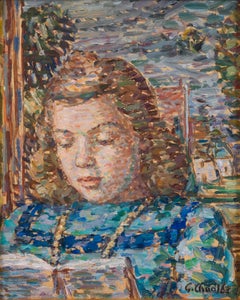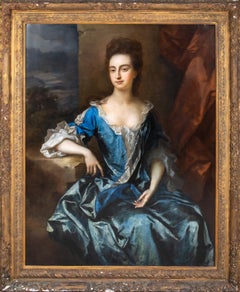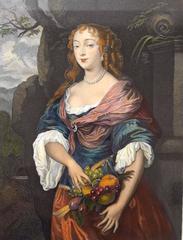Sir Peter Lely Art
Dutch, 1618-1680
Sir Peter Lely (1618-1680) was born in Germany at Soest in Westphalia in 1618. Though his family name was van der Faes, he assumed the name Lely after the lily that was carved on the gable of his father’s home in The Hague. He moved to England in 1641, the year that Van Dyck died, and succeeded Van Dyck. He was court painter to Kind Charles I and King Charles II. By working for many of the patrons of the late van Dyck, Lely rapidly established himself as one of the country’s most important portrait painters.to
3
4
4
4
1
1
Portrait of Barbara Palmer 1st Duchess of Cleveland
By Sir Peter Lely
Located in Taunton, GB
Portrait of Barbara Palmer 1st Duchess of Cleveland 1640-1709, half-length wearing a red dress and portrayed within a cartouche.
Circa 1680
Oil On...
Category
17th Century Sir Peter Lely Art
Materials
Oil
Portrait of Bridget Drury Lady Shaw, formerly Viscountess Kilmorey
By Sir Peter Lely
Located in London, GB
Sir Peter Lely (Soest 1618 – 1680 London)
Portrait of lady with a crown, possibly Bridget Drury Lady Shaw, formerly Viscountess Kilmorey, later Lady Baber (d.1696) c.1665
Oil on canvas
46 1/2 x 40 3/4 inches, Framed
42 1/4 x 36 1/4 inches, Unframed
Inscribed left [……….]Isabella
James Mulraine wrote the following for this piece:
This portrait dates to the middle of the 1660s, the decade when Lely’s career took off as successor to Sir Anthony van Dyck. At the Restoration Charles II had appointed him Principal Painter to the King and paid a pension £200 per annum ‘as formerly to Sr. Vandyke...’1 Lely had trained in Haarlem and he was in his early twenties when he came to London in 1643. He was an astute businessman and a wise courtier. In 1650 he painted a portrait of Oliver Cromwell (Birmingham Museum and Art Gallery) while maintaining links with the Royalist exiles through the 1650s. He had arrived in England as a painter of small-scale portraits and lush scenes of nymphs in landscapes in a Dutch style. His experience of Van Dyck in English collections transformed his painting. His lavish and alluring vision of Arcadia exactly captured the spirit of the Court and as Principal Painter he dominated English portraiture for the next twenty years. Lely ran a highly efficient studio along Netherlandish lines, employing a team of specialists like the drapery painter John Baptist Gaspars and young artists-in-training like Nicolas de Largilliere. He had numerous rivals during that period, and by 1670 he had introduced numbered standard poses to speed up production, while collaborating with printmakers for further revenue and advertising. He died in 1680 of a stroke while painting, working to the last.
The portrait, painted at a date when Lely’s poses and execution were still individual and inventive shows a lady sitting at three-quarter length facing away from the viewer. She has begun to turn towards the viewer, a pose with a long pedigree in art, first used by Leonardo da Vinci in the Mona Lisa (Louvre). She steadies her blue drapery where it might slip from her arm with the movement, a flash of realism beautifully captured. Like Van Dyck, Lely painted his female sitters in a timeless costume rather than contemporary fashion, showing a loose gown and floating silk draperies. It presented the sitter as a classical ideal. The portrait would not date.
The saffron dress may be the work of a drapery painter but the brown scarf must be by Lely himself, and appears unfinished, broadly sketched in behind the shoulder. The delicate blue glaze and nervous highlights suggest shimmering translucence. Lely was a master of painting hands – his hand studies are marvels of drawing – and the lady’s hands are superb, exactly drawn, delicately modelled and expressive. The fidgety gestures, clutching the gown, fiddling with the edge of the scarf, give the portrait psychological bite, suggesting the personality behind the calm courtier’s expression, adding to the sense shown in the look of the eyes and mouth that the lady is about to speak. The portrait’s language is Vandykian. The inspiration comes directly from Van Dyck’s English portraits of women. Lely owned Van Dyck’s Portrait of Lady Elizabeth Thimbleby and Dorothy Viscountess Andover (National Gallery, London) and the sitter’s costume quotes Lady Andover’s saffron dress and brown scarf. But Lely paints a generation who sat nearer to the ground and through a dialogue of expression and gesture he shows sitters who are more flesh and blood than Van Dyck’s.
The background with a column and curtain is different to those shown in most of Lely’s portraits of women. They tend to include trees or fountains, with a glimpse of landscape. But there are other examples. A portrait of the King’s reigning mistress, Barbara Villiers Duchess of Cleveland...
Category
1660s Sir Peter Lely Art
Materials
Oil
$70,758 Sale Price
20% Off
Portrait Of Philadelphia, 17th Century Probably Philadelphia Carey Of Aske Hall
By Sir Peter Lely
Located in Blackwater, GB
Portrait Of Philadelphia, 17th Century
Probably Philadelphia Carey Of Aske Hall, Richmond, North Yorkshire, English Courier & Lady In Waiting to Princess Elizabeth
Studio Of Sir Pe...
Category
17th Century Sir Peter Lely Art
Materials
Canvas, Oil
$22,842 Sale Price
30% Off
English 17th century portrait of a lady
By Sir Peter Lely
Located in Bath, Somerset
A 17th century English portrait of a lady by Sir Peter Lely (1618-1680), half-length in a painted feigned oval, wearing a green silk gown with chestnut coloured cloak over one shoulder, her fair hair curled in the fashionable ringlet style of the period. Oil on canvas in an English giltwood 'Lely' frame.
We are grateful to Diana Dethloff and Catharine MacLeod (who are currently working on a Lely catalogue raisonné) for their confirmation of Lely as the artist from photograph analysis of this previously unidentified early work.
Provenance:
Private collection Nottingham until 2021
Mellors and Kirk sale December 2000, lot 1173
The sitter is likely to have been from an upper class or aristocratic family in court circles, who were the main source of Lely`s patronage. The simple composition serves to highlight the beauty of the sitter through portraying her pale decolletage and complexion, set against the gentle gaze of her blue eyes, the soft blush of her cheeks and her full red lips.
Peter Lely (1618-1680) was originally of dutch origin and became Principle Painter to the King in 1661, following in the footsteps of Van Dyck who had died in 1641. He dominated the portrait painting scene in England for over 20 years, creating a distinctive 'court look' in his work which had a strong influence on many other artists. He had an extremely successful and popular portrait practice which meant that he soon had to develop production methods that could accommodate the high demand for portraits, and also for copies and versions of them which were given as gifts to family and courtiers. The use of studio assistants was a common practice for busy artists and as with Van Dyck, Lely is known to have used specialist assistants to execute particular parts of his paintings. Artists who worked in Lely`s studio included John Baptist Gaspars who specialised in drapery painting, William Wissing, John Greenhill...
Category
17th Century Baroque Sir Peter Lely Art
Materials
Canvas, Oil
$23,930 Sale Price
20% Off
Related Items
LARGE FRENCH CONTEMPORARY ABSTRACT CUBIST PAINTING - R. LEROY - OCHRE COLORS
Located in Cirencester, Gloucestershire
Artist/ School: Rene Leroy (French b. 1932)
Title: Abstract/ Cubist Composition
Medium: oil on canvas, framed, signed
Size: framed: 28.25 x 28.25 inches
painting: 2...
Category
21st Century and Contemporary Abstract Sir Peter Lely Art
Materials
Oil
$713 Sale Price
47% Off
H 28.25 in W 28.25 in
A Young Girl Reading a Book, Pointillist Artist
Located in Stockholm, SE
"A Young Girl Reading a Book" is a captivating portrait by Swedish artist Gustaf Arnolds.
Arnolds was a prolific painter whose roots began in Vingåker and later in Ronneby from his teenage years.
His educational journey in art took him through prestigious institutions such as Althins målarskola and the Tallbergska grafikskolan in Stockholm,
followed by a significant period at the Konstakademien, Stockholm, between 1904 and 1909. His talent and dedication were recognized early on, earning him a scholarship to Paris, a city that would deeply influence his artistic direction.
This particular work, likely painted shortly after his return to Sweden, reveals a profound influence from his time in Paris. It portrays a young girl absorbed in reading a book, a simple yet profound subject that Arnolds imbues with a sense of tranquility and introspection. The background hints at a serene landscape, dotted with quaint houses, a nod to the everyday beauty surrounding us. What sets this piece apart is Arnolds’ technique, reminiscent of pointillism but distinguished by longer, more expressive brush strokes that add a vibrant texture and depth to the canvas. This method showcases Arnolds' unique adaptation of the techniques he encountered during his Parisian studies, particularly during his interactions with Nils Dardel...
Category
1930s Pointillist Sir Peter Lely Art
Materials
Masonite, Oil
$1,710 Sale Price
20% Off
H 16.15 in W 13.39 in
Les Jockey & La Propietaire - Post Impressionist Figurative Oil by E Grau Sala
By Emilio Grau Sala
Located in Marlow, Buckinghamshire
Signed, titled and dated figures in landscape oil on canvas by Spanish post impressionist painter Emilio Grau Sala. The work depicts a large group of jockeys and horse owners talking...
Category
1970s Post-Impressionist Sir Peter Lely Art
Materials
Canvas, Oil
Still Lives Triptych - Oil on Canvas attr. to F. Guardi - Late 18th Century
By Francesco Guardi
Located in Roma, IT
This is a wonderful Guardi's Triptyc, composed by three oval oil painted panels attributed by some of most reputable scholars to the Venetian old master Francesco Guardi (1712-1793)....
Category
Late 18th Century Sir Peter Lely Art
Materials
Oil, Canvas
$199,582
H 28.35 in W 23.63 in D 1.19 in
French Impressionist Painting Portrait of a Young Girl Paris School
Located in Rochester, NY
Striking French impressionist portrait of a young girl. Oil on board. Original carved frame. Circa 1950's. Signed illegibly lower right.
Category
Mid-20th Century Impressionist Sir Peter Lely Art
Materials
Oil
$1,275
H 17 in W 15 in D 2 in
Antique American School Post Impressionist Modern Portrait Framed Oil Painting
Located in Buffalo, NY
Antique American school modernist portrait painting. Housed in a period frame. Measuring 29 by 33 inches overall and 20 by 24 painting alone.
Category
1930s Modern Sir Peter Lely Art
Materials
Canvas, Oil
$1,775
H 33 in W 29 in D 2 in
Portrait of a Nobleman, French School 17th Century
Located in New York, NY
French portrait of a nobleman, 17th Century, great condition. With a beautiful carved wooden frame.
Category
17th Century Baroque Sir Peter Lely Art
Materials
Canvas, Oil
LARGE FRENCH CONTEMPORARY ABSTRACT CUBIST PAINTING - RENE LEROY (B.1932)
Located in Cirencester, Gloucestershire
Artist/ School: Rene Leroy (French b. 1932) signed
Title: Abstract/ Cubist Composition
Medium: mixed media, material and oil on canvas, framed, signed
Size: frame: 29.5 x 37 ...
Category
21st Century and Contemporary Abstract Sir Peter Lely Art
Materials
Oil
$713 Sale Price
30% Off
H 29.5 in W 37 in
Mannerist Italian painter - 16th/17th figure painting - Madonna praying
Located in Varmo, IT
Umbrian-Roman Master (16th-17th century) - Madonna in Prayer.
84 x 58.5 cm unframed, 96 x 70.5 cm with frame.
Antique oil painting on canvas, in a wooden frame (not signed).
Condi...
Category
16th Century Mannerist Sir Peter Lely Art
Materials
Canvas, Oil
$2,139 Sale Price
35% Off
H 37.8 in W 27.76 in
17th Century By Gian Giacomo Barbelli Paradise and Purgatory Oil on Canvas
Located in Milano, Lombardia
Already been in Koelliker collection (no. inv. LK0431)
Publications:
- C. Alpini, Ritratto di Gian Giacomo Barbelli nel IV centenario della nascita, in “Insula Fulcheria”, XXXIV, ...
Category
17th Century Old Masters Sir Peter Lely Art
Materials
Canvas, Oil
$36,875 Sale Price
20% Off
H 28.35 in W 21.66 in D 1.97 in
Mid-17th-Century Spanish School Oil Painting, Portrait Of A Theologian
Located in Cheltenham, GB
This mid-17th-century Spanish oil on canvas depicts a dignified man of learning - a theologian, or perhaps a cathedral canon.
Dressed in a black cassock, marked by a vertical row of...
Category
Mid-17th Century Baroque Sir Peter Lely Art
Materials
Canvas, Oil
$4,282
H 30.5 in W 27 in D 2 in
Antique Western Oil on Canvas Painting Native American "The Captive" 1901
By Frank Paul Sauerwein
Located in Portland, OR
A large American Western, Native American oil on canvas landscape, by Frank Paul Sauerwein (1871-1910), "The Captive", 1901.
This large oil on canvas depicts a Native American brave captively tied to a tree stump and being viewed by a rival tribe, who are evidently deciding his fate. Behind the collected tribe of elders, braves and children are a pair of conical tipi dwellings, to the background are grazing horses and another group of native people in a tree lined setting. The painting is indistinctly signed lower left, condition is good, the painting is housed in the original frame with a giltwood rabbet, the painting at sight is 40" x 26".
Provenance; From a lifelong collection of 19th & early 20th Century Western Art, Portland, Oregon.
Frank Sauerwein was a respected painter of western landscapes, Indian portraits, Indian genre scenes, and California missions. His promising career was cut short by his death of tuberculosis at age thirty-nine.
The son of European-trained artist, Charles D. Sauerwein, Frank took his first art lessons from his father before studying at the Philadelphia School of Industrial Art, the Pennsylvania Academy of Fine Art, the Art Institute of Chicago and, finally, the Philadephia Museum School of Art. In 1891 he moved to Denver in hope of improving his health.
In 1893, Sauerwein accompanied the artist Charles Craig on a trip to the Ute reservation in southwestern Colorado. This began Sauerwein's unyielding fascination with the Southwest and its Native inhabitants. After a trip to Europe, he returned to the American West, visiting Taos in 1899 and Santa Fe in 1900. That same year, Sauerwein visited the Navajo reservation, becoming good friends with trading post entrepreneur, Lorenzo Hubbell. He also spent time at Keam's Canyon on the Hopi reservation where he sketched local inhabitants.
Sauerwein moved to Los Angeles in 1901, and then to Pasadena in 1902, but he maintained his contacts in the Southwest with Summer trips to the Grand Canyon, New Mexico Indian Pueblos, Taos, Santa Fe and Albuquerque. He especially loved the Grand Canyon which is the subject of a large number of his paintings.
Rendered in a tight, academic style, Sauerwein's paintings clearly show the influence of German...
Category
Early 1900s Sir Peter Lely Art
Materials
Canvas, Oil
$4,500
H 36 in W 50 in D 2.75 in
Previously Available Items
Portrait Of Mrs Elizabeth Levinz (nee Livesay), 17th Century by SIR PETER LELY
By Sir Peter Lely
Located in Blackwater, GB
Portrait Of Mrs Elizabeth Levinz (nee Livesay), 17th Century
by SIR PETER LELY (1618-1680)
Large 17th Century portrait of Mrs Elizabeth Levinz (nee Livesay), oil on canvas by Sir P...
Category
17th Century Sir Peter Lely Art
Materials
Canvas, Oil
Elizabeth Lady Denham
By Sir Peter Lely
Located in Saint Augustine, FL
An original hand colored copper plate engraving after Dutch artist Sir Peter Lely (1618-1680) titled "Elizabeth Lady Denham", 1833. Engraved by English artist Thomas Wright (1792-1849) in 1833. Incredibly framed with moulding from Spain, matting from Holland, all archival. Framed size: 21" x 17.75". Image size: 6.5" x 5". Mint condition.
Sir Peter Lely (14 September 1618 – 30 November 1680) was a painter of Dutch origin, whose career was nearly all spent in England, where he became the dominant portrait painter to the court.
Thomas Wright (1792–1849) was an engraver and portrait-painter. After serving an apprenticeship with Henry Meyer, and worked for four years as assistant to William Thomas Fry, for whom he engraved the popular plate of Princess Charlotte and Prince Leopold in a box at Covent Garden Theatre. About 1817 he began to practise independently as a stipple-engraver, and also found employment in taking portraits in pencil...
Category
1830s Old Masters Sir Peter Lely Art
Materials
Copper
Sir Peter Lely art for sale on 1stDibs.
Find a wide variety of authentic Sir Peter Lely art available for sale on 1stDibs. You can also browse by medium to find art by Sir Peter Lely in oil paint, paint, canvas and more. Not every interior allows for large Sir Peter Lely art, so small editions measuring 21 inches across are available. Customers who are interested in this artist might also find the work of Giovan Battista Viola, and Suzi Fadel Nassif. Sir Peter Lely art prices can differ depending upon medium, time period and other attributes. On 1stDibs, the price for these items starts at $11,379 and tops out at $83,120, while the average work can sell for $30,579.
Artists Similar to Sir Peter Lely
Questions About Sir Peter Lely Art
- 1stDibs ExpertJanuary 19, 2025Sir Peter Blake was famous for his influence on the art world. He is widely regarded as the godfather of British Pop art and the Young British Artists (YBA) movement. Blake created paintings, collages and prints that blended modernity and nostalgia. Though best known for designing the album cover for the Beatles’s Sgt. Pepper’s Lonely Hearts Club Band, he considered painting to be central to his oeuvre. While celebrity figures such as Marilyn Monroe informed Blake's work, folk art, fairground signs and an overall sense of nostalgia also influenced his style. On 1stDibs, explore an assortment of Peter Blake art.
